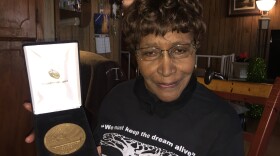Alabama Public Radio is celebrating forty years on the air in 2022. The APR news team is diving into our archives to bring you encore airings of the best of our coverage. That includes this story from 2020. APR student intern Sydney Melson produced this feature on so called “segregation academies” in Alabama. Here’s that story from the APR archives.
Across the state, many private academies started as a place to bypass desegregation laws. Jennifer Belcher-Glass, an alumnus of the now-closed Marengo Academy in Linden, Alabama, graduated from the school in 2014 and said the lack of diversity was a fact of life.
Marengo Academy and many others like it are sometimes called “segregation academies.” These academies started as a way for white people to avoid desegregated public schools.
“If you were in the area and someone said MA is an all-white school, it would kind of be the same thing as if you just said the sky is blue or the grass is green,” she said.
Belcher-Glass said there were a few people of color in the school, but no Black students. Once she started college, Belcher-Glass said the shift in demographics from no black people to roughly 40% Black students was a difficult adjustment at first.
“It was a bit weird because I wasn't in that demographic setting since I was in middle school,” she said.
Six years after graduating, she said she realized this form of “legal segregation” was wrong and the closure of Marengo Academy was a step in the right direction.

University of Alabama Historian John Giggie said these kinds of private academies existed before desegregation occurred. He said in the beginning, the academies were either elite preparatory schools or religiously oriented. Their purpose changed during the civil rights movement.
“The segregation academy movement picked up steam and became explicitly about refusing to allow Black and white children to go to school together,” Giggie said.
Barry McNealy, a coordinator for youth leadership at the Birmingham Civil Rights Institute, said the history of segregated schools is deeply rooted in white supremacist values. McNealy said many efforts were made by racist whites to stop desegregation.
He said those efforts included legislation such as the pupil placement law, or more violent acts such as the 16th Street Baptist Church bombing in 1963.
He quoted Klansman Robert Chambliss, one of the bombers responsible for the deaths of four young black girls: “Wait until after this Sunday and they'll beg us to segregate.”
Over time, the segregation between private schools and public schools remained mostly consistent. Though Marengo Academy closed, Belcher-Glass said many students would relocate to another private school rather than attending a public school.
“They’re not A or B schools,” Belcher-Glass said about the public schools. “They’re considered failing schools, but they’re also considered Black schools.”
Giggie said this difference between pass or fail between the school types encouraged parents to choose the private option.
“When you look at private schools there, you see perhaps a greater student to teacher ratio or more attention pay to students intellectually,” he said. “That seems to be the driving force that's propping up segregation academies today.”
McNealy agreed private schools typically have a better quality of education than public schools but doubted that was the only reason people continued to send their children there.
“You have people thinking that if my child is educated alongside an African-American child or Latinx child, then that somehow is going to detract from the ability that my child has to learn,” McNealy said. “I've yet to see one student be able to diminish another student’s educational capacity.”
Some private academies are making the effort to address this lack of diversity. John McWilliams, headmaster of Montgomery Academy, said it is important for them to acknowledge their past. He said it is also important to talk about what obligation private academies have to their communities.

“I'm really proud of our Black student leaders who have you stepped up and created a cultural awareness club,” McWilliams said. “They led a Black history culture fair on our campus back in February that was really a powerful moment for our students, our faculty, to engage in an interactive exhibit on our campus, exploring components of Black culture and our African-American history.”
Giggie urged private academies to evaluate their role as a propagator of modern segregation.
“What does it mean that the schools you helm are essentially enclaves for the children of wealthy white people?” he said. “Can we challenge them to say that there's more than that? That's not good enough in the 21st century.”
McNealy said change has to come from our communities by condemning segregationist and white supremacist values.
“This is not something that will go away because of legislation or a court case,” he said. “A lot of this is passed down, and until it's not passed down any longer, people will have to fight and stand up for what they know is in the best interest of all Americans and not just some Americans.”




















